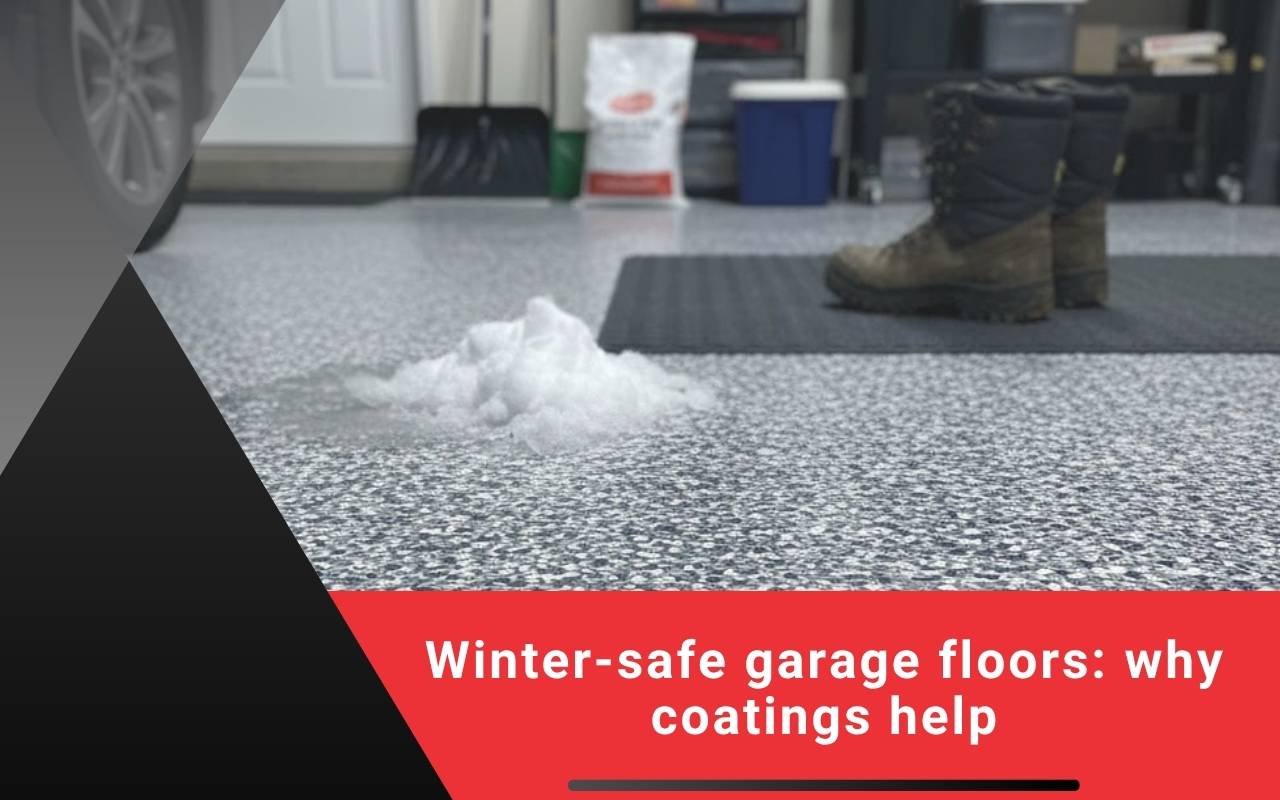BLOG

Winter-safe garage floors: why coatings help
Winter brings moisture, salt, and freezing temperatures that quickly wear down bare concrete. Applying a garage floor coating creates a durable shield that boosts winter safety by reducing slips, blocking freeze–thaw damage, and resisting corrosive road salt. With options like epoxy and fast-curing polyaspartic, you can protect your garage, improve traction, and keep surfaces safer all season long.
Why coatings matter in winter
The cold brings moisture, salt, and ice. These attack bare concrete and raise slip risks. Coatings boost Garage Floor Winter Safety by sealing pores and improving traction.
Choose wisely. Epoxy vs polyaspartic affects durability and downtime. Polyaspartic cures fast in cold. That makes winter projects practical, especially when weather windows are short.
Benefits of garage floor coatings in winter
Coatings block water and road salt. They reduce cracking, flaking, and staining. They also clean easily and look great.
Moisture barrier that stops freeze–thaw damage
Resistance to salt and deicing chemicals
Improved traction with decorative flakes or texture
Easier sweeping and mopping during winter maintenance
Upgrading helps Garage Floor Winter Safety and lowers repair costs. It also supports everyday use when slush and grit appear.
Protection against water, salt, and ice
Untreated concrete absorbs water. When it freezes, tiny cracks grow. A coating seals those pores and limits expansion damage.
Salt speeds wear and discoloration. A sealed surface sheds ice easier. That supports Garage Floor Winter Safety on busy days.
Epoxy vs Polyaspartic: what to know
Understanding epoxy coatings
Epoxy bonds tightly to concrete and resists spills and abrasion. It offers a glossy look and solid value for many homes.
Cold slows epoxy cure. Longer downtime can complicate winter maintenance. Careful prep and heat control improve results.
Exploring polyaspartic coatings
Polyaspartic applies in cooler conditions and cures fast. It resists UV fade and holds color well over time.
Its flexibility handles temperature swings. Faster return to service helps Garage Floor Winter Safety during winter rush.
Durability comparison: epoxy vs polyaspartic
Epoxy: very hard, budget friendly, proven track record
Polyaspartic: flexible, strong impact resistance, better UV stability
Both protect well; your choice depends on priorities and climate
In harsh winters, polyaspartic often keeps its finish longer. Epoxy still shines for tight budgets and steady use.
Quick curing solutions for cold weather
Polyaspartic often allows foot traffic within hours. That reduces downtime when temperatures drop. It tackles curing time cold effectively.
Some epoxy systems use accelerators. They still need controlled temperature and humidity. Fast cures limit dust and moisture issues.
Anti-slip properties for safe winter surfaces
Texture reduces slips from meltwater refreezing. Add quartz sand or polymer grit for better grip and safer steps.
Select anti-slip grade for your needs
Blend flakes for style and traction
Adjust texture for easy cleaning
Local pros can tune blends for garage coating Omaha projects. That balance supports Garage Floor Winter Safety daily.
Customizing coatings to your needs
Pick colors that brighten winter light. Decorative flakes hide small debris. UV-stable topcoats resist yellowing under lights.
Match thickness to usage. Heavier vehicles may need more build. For options, see floor coating Nebraska for regional guidance.
Maintenance tips for winter-safe garage floors
Sweep grit and salt often. Mop with mild soap and warm water. Avoid harsh acidic cleaners that dull finishes.
Dry puddles after storms. Repair chips quickly to block moisture. These steps strengthen Garage Floor Winter Safety through the season.
Frequently Asked Questions
How do coatings improve winter safety? They seal concrete and add texture, reducing slips and freeze–thaw damage.
Which is better in cold weather, epoxy or polyaspartic? Polyaspartic cures faster in cold and returns to service sooner.
Can I add anti-slip without losing easy cleaning? Yes. Choose a fine aggregate that balances grip and smooth cleanup.
How do I handle curing time cold? Use polyaspartic or epoxy with accelerators, and control heat and humidity.
Where can I learn about long-term results? Review insights on floor coating garage longevity before choosing.
Ensuring a secure and durable garage space
Balance durability, curing time cold, and anti-slip features. For deeper tips, see garage floor protection resources.
Need help with garage coating Omaha choices? Reach out via the contact page. Plan now to lift Garage Floor Winter Safety before the next storm hits.

Cracks, gaps, and surface wear weaken concrete, causing costly damage. You need a solution that lasts. That’s where we come in. Our expert team specializes in sealing and caulking, ensuring durable surfaces that withstand time and weather.




